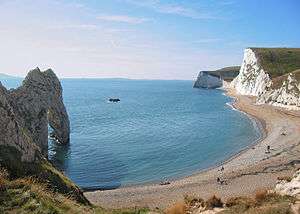Jurassic Coast
The Jurassic Coast is the popular (and now official) name given to a 95 mile (155 km) long stretch of coastline in southern England, incorporating parts of the east Devon and Dorset coasts.

The Jurassic Coast was inscribed as a World Heritage site in 2001 on account of its importance to geology, palaeontology and the sheer beauty of its landscape. The area attracts hundreds of thousands of fossil hunters, hikers, campers and beach-goers each year.
Towns
Other destinations
Understand
Many of the earliest recognised scientific dinosaur discoveries were made along the Jurassic Coast in the early 19th century, promoting the rise of the science of paleontology. Pioneering fossil hunters like Mary Anning took advantage of the coast's highly fossiliferous cliffs.
Get in
There is a South Western Railways service from London Waterloo to Poole and Exeter.
Get around
The Jurassic Coast X53 bus service from Exeter to Poole via Sidford, Beer, Seaton, Lyme Regis, Charmouth, Bridport, West Bay, Abbotsbury, Weymouth, Wool and Wareham can be used by walkers who wish to do a linear walk along the coast.
See
The attractions of the Jurassic Coast are many. Not to be missed, however, are:
Eat
- Being on the coast, fresh fish & chips is widely available.
Drink
Stay safe
Cliffs can be prone to rockfalls, so avoid walking directly beneath them. This is not an abstract risk: people are killed this way with regrettable frequency.
Go next